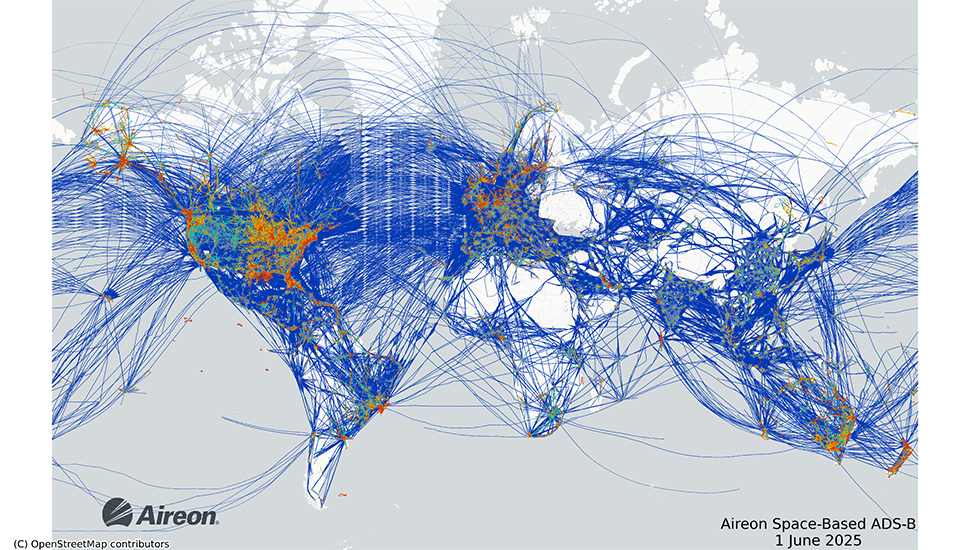Steering clear of turbulence
New system offers promise of guiding flights worldwide away from rough air
Jul 1, 2025 - by David Hosansky
Jul 1, 2025 - by David Hosansky

This image shows all the space-based ADS-B data captured by Aireon for a single day. The color of each track shows the altitude band the aircraft was flying within. (Image courtesy Aireon, LLC.)
Passengers on flights around the globe may soon enjoy a safer, more comfortable ride, thanks to a new system under development at the U.S. National Science Foundation National Center for Atmospheric Research (NSF NCAR).
The prototype turbulence detection system aims to better guide aircraft away from areas of rough air. It’s designed to detect the intensity of turbulence as the plane flies through bumpy air, which can be used to alert pilots in the area as well as air traffic controllers and others about locations to avoid.
The system leverages new protocols adopted in recent years by the international aviation industry, which require aircraft to transmit their locations in real time with a technology known as Automatic Dependent Surveillance–Broadcast (ADS-B). Using this data can result in far more information about turbulence worldwide than pilots manually contacting air traffic controllers when they run into significantly turbulent conditions.
“This is a potential game changer because it’s providing vastly more observations of turbulence than we currently have,” said NSF NCAR scientist Larry Cornman, the new system’s lead developer. “This is the biggest advance in turbulence avoidance in many years.”
He noted that flights over the contiguous United States already benefit from a turbulence guidance system that was developed years ago at NSF NCAR.
The new system, called the NSF NCAR ADS-B Turbulence Detection Algorithm, is being tested by two private partners of NSF NCAR. In contract with the Federal Aviation Administration (FAA), L3Harris, a technology and information services company, recently demonstrated the effectiveness of the system when aircraft flying over land transmit their location to ground-based stations. Aireon, which specializes in aircraft tracking and surveillance, is conducting an analysis of the system’s effectiveness when aircraft transmit their location to satellites.
The research is funded by the FAA and Aireon.
Turbulence is the leading cause of accidents among large, U.S.-based passenger airlines and cargo operators, according to the National Transportation Safety Board. Extreme turbulence can lead to serious injuries among passengers and crew, while turbulence-related costs — including injuries, equipment damage, inspection, maintenance, and rerouting — are estimated to total $100 million or more annually in the U.S. alone.
For more than two decades, NSF NCAR has worked with the FAA to help guide flights over the contiguous U.S. away from turbulence. The Graphical Turbulence Guidance (GTG) system, developed at NSF NCAR and continuously upgraded since being adopted for use by the National Weather Service in 2003, identifies regions of turbulence by applying specialized algorithms to high-resolution weather forecasts.
Pilots on intercontinental routes, flying aircraft in regions with less-detailed weather forecasts, have had to make do without such warnings about turbulence. But a new opportunity arose with the international aviation industry requiring commercial airplanes to transmit their position in real time using ADS-B.
Cornman and his colleagues realized they could leverage ADS-B to monitor the vertical movements of aircraft, potentially inferring the location and intensity of turbulence. Such an approach offered the promise of providing a far more complete picture of turbulence around the globe than currently exists. That’s because aircraft on some 200,000 daily flights worldwide automatically transmit their locations via ADS-B. In contrast, air traffic controllers receive only up to about 1,500 daily reports of turbulence under the current voluntary approach in which pilots, largely over the U.S. and North Atlantic, let air traffic controllers know when they encounter turbulence.
The research team, however, faced major challenges that took several years to overcome.
One of the issues was the imperfect nature of ADS-B data, with aircraft transmitting their positions at irregular intervals. This is advantageous for air traffic control so it doesn’t have simultaneous signals coming from multiple aircraft taking off and landing at an airport. But mapping out regions of turbulence, which evolve rapidly in the atmosphere, would ideally involve receiving updates on a plane’s position on a consistent basis, such as every half-second or greater.
Another fundamental issue was determining whether a plane’s movements were related to turbulence or another cause, such as a pilot deciding to change altitude. Unlike the GTG system in the contiguous U.S. that infers turbulence from atmospheric conditions, the scientists focused on trying to infer turbulence from the movements of a plane.
Once Cornman and his colleagues developed specialized algorithms to overcome these challenges, they tested the system’s accuracy by comparing it with both voluntary pilot notifications and automated reports from an earlier system that NSF NCAR developed for commercial transport aircraft. They found, in 90% of the cases, the new system generated results that either matched the notifications and reports or were just off by a single turbulence category on a scale that ranges from light to extreme. For example, if the system indicated light turbulence, pilots at the same time were reporting either light or light-to-moderate turbulence.
With the system demonstrating its effectiveness, Cornman and his team are working with the FAA and private partners to transition it into a technology that airlines can readily adapt. This will involve such upgrades as transmitting real-time turbulence updates to pilots in an easily accessible format.
“We’re working through the nitty gritty details to move it from my laptop to applying it in the real world,” Cornman said. “The potential of this system is enormous, and we look forward to operationalizing it so that flights over the globe become safer and more comfortable.”
This research is in response to requirements and funding by the Federal Aviation Administration (FAA). The views expressed are those of the authors and do not necessarily represent the official policy or position of the FAA.